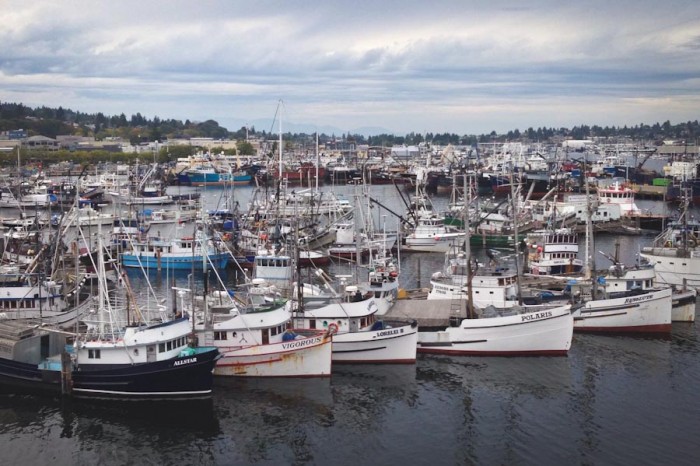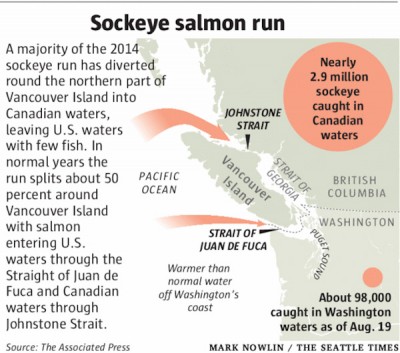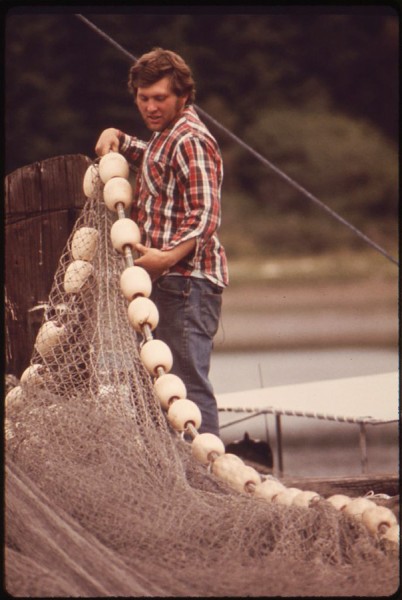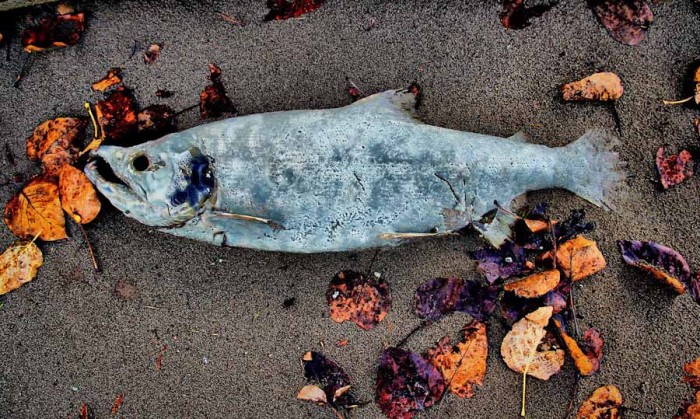The Memories has been in Chuck Horjes’s family for 54 years. He began as a teenage deckhand in the 1970s, eventually working his way up to his current position as captain of the 54 56 foot commercial fishing vessel.
Over the years he has travelled up and down the West Coast from Alaska to Oregon in search of salmon. This year he decided to fish an area known as the “salmon traps” near the San Juan Islands in Washington — where forecasts predicted millions of sockeye would pass in late August on their way home to the Fraser River in British Columbia.
Unfortunately for the crew of The Memories and the other Washington fishermen, those predictions did not play out as anticipated.
“On an average year we normally catch close to 200,000 pounds fishing Puget Sound,” said Horjes.
This year Horjes’s boat caught a scant 3,000 pounds of Fraser River sockeye. For someone used to buying fish at the grocery store, that may sound like a lot of salmon. But for a commercial fishing crew, who sell the fish to a distributor at a much lower price, it isn’t even enough to cover the cost of going out to fish in the first place.
The crew of The Memories were not alone in having a slow season. The U.S. fishing fleet in the Puget Sound caught a mere 98,000 Fraser River sockeye salmon this August. Things picked up slightly so far in September bringing the total U.S. catch to 354,600.

Meanwhile, Canadian boats caught 6.7 million of the fish — around 28 million pounds — during that same period, according to the Pacific Salmon Commission (PSC), the group responsible for monitoring the sharing of the fishery between the U.S. and Canada. Their catch flooded the market with fresh sockeye, driving the price fishermen on were paid down to $1.40 per pound by the end of August.
Known as the Pacific Salmon Commission treaty, the fish sharing agreement between the U.S. and Canada has worked pretty well since its implementation in 1985, with fishermen from each nation typically catching similar numbers of Fraser River sockeye.
So what happened this year?
U.S. fishing crews can thank a blob of warm water for their lackluster haul this summer. Specifically, a 100 meter deep layer of warm water that built up due to an extended period of very mild weather over the Pacific Ocean, according to National Oceanic and Atmospheric Administration (NOAA) research scientist Nick Bond. NOAA is the federal agency tasked with studying the climate, weather and marine life.
Most years the Fraser River sockeye salmon run splits on the journey home, with about half journeying up the strait of Juan De Fuca through Washington waters. This year, 99% of the Fraser River salmon took the alternate route, the Johnstone strait around Vancouver Island, avoiding the “blob” of water 1.5-3 degrees Celsius warmer than usual — and evading Washington fishing crews altogether.

So while Washington fishermen tugged up empty set after empty set, Canadian crews were having the season of their lives. This disparity has reignited discussions about the myriad issues that come with the sharing of the Pacific Coast salmon fisheries.
“If fish don’t come into Washington, we should be able to go into their waters and catch some,” said Horjes, shaking his head.
Horjes’s boat is one of a number of commercial fishing boats that call Gig Harbor, in the south Puget Sound, their home port. Most of the boats are purse seiners, passed down for generations within families who immigrated to the U.S. years ago, mostly from Croatia.
Though in a lot of ways fishing boats and permits are similar to a family farm — worth a lot of money, but costly and time consuming to maintain and unpredictable in terms of income year to year — they don’t come with the same protections and government programs like crop insurance and federal subsidies to help them survive the bad years.
“I don’t know if it will put any boats out of business, but it will definitely hamper them,” said Horjes. “Captains with loans may have to go back to their lenders and see if they can change their arrangements. It could end up putting some out of business.”
The PSC will meet in October in Vancouver BC to discuss their “forward looking agenda”, and this year’s sockeye returns will likely be discussed then.
Another important topic of discussion will be the care and maintenance of Canada’s Fraser River, following an incident of massive habitat destruction that could jeopardize both countries’ fisheries in years to come.
The breach of a tailings pond at a gold and copper mine owned by Imperial Metals poured an estimated 2.8 billion gallons of waste water into the Fraser River, according to the company’s own estimate.
“High levels of metals are often acutely lethal to fish and other aquatic species,” explained NOAA Fisheries scientist Nathaniel Scholz.
Even if the copper toxicity doesn’t kill salmon returning to the Fraser River to spawn, the Mount Polley spill could spell trouble for future generations.
Scholz has participated in several studies of the effects of low-level copper exposure on salmon in the Pacific Northwest. In a 2012 study he and his colleagues found that juvenile salmon exposed to copper become less aware of predators, upping the chance that they will be eaten before they reach adulthood.
“Mine spill accidents happen, all around the world,” said Scholz. “Often the consequences are spectacularly severe.”
When asked what the top concerns for salmon of the future would be, another NOAA research scientist Nate Mantua chuckled.
“They’ve got to eat and they’ve got to avoid predators,” said Mantua. “When they go to sea they look just like a forage fish, but they make a pretty quick transition to becoming a super predator, I’ve heard people compare them to the tigers and the lions of the sea.”
Even for a super predator the ocean is a dangerous place, and the exposure to copper could lower the fishes natural defenses.

“For every 100-200 salmon that go to sea, maybe in a great year ten of those survive to adulthood,” explained Mantua. “In a terrible year, maybe it’s one in a thousand that survive.”
Fish that spawn in Canadian streams are often caught by American fishermen — as exemplified by the Fraser River fishery — so transnational cooperation is vital when it comes to inland environmental protections as well.
Mining operations and other environmental hazards that threaten salmon habitats aren’t just a Canadian issue. The proposed Pebble Mine would span 20 square miles of state land in Alaska at the headwaters of Bristol Bay. If that mine were to have a tailings spill similar to the one at Mount Polley, it would devastate the $500 million Bristol Bay salmon fishery.
Recent ocean warming and environmental threats notwithstanding, Mantua still believes that the long term outlook is solid for both Puget Sound salmon and the commercial fishermen who make a living catching them. And Puget Sound fishing crews are equally optimistic about their industry’s future. Fall fishing will begin October 15 with around a million pink chum salmon expected to arrive in the South Sound and Hood Canal.
“The outlook is good if everything falls into place,” said Horjes. “There are a lot of variables you can’t control: the state, the water temperature, the feds, foreign fishermen and catastrophes.”
Bond said that the warm layer of water may persist into next season, depending on conditions this winter.
“It will take more than one storm to calm down, we would need a stormy season out there to get rid of it,” said Bond.
But unless the treaty rules change to guarantee more dependable sharing of the fish on years the salmon choose to divert around the north end of Vancouver Island, Washington fishing may just be too risky for some fishermen.
For his part, Horjes says he’s planning to forgo the San Juans and fish back in Alaska next Summer.
This post has been updated since it’s original publication.



October 15 brings chum salmon. Not pinks.
Thanks for pointing this out, James, the correction has been made!
Thanks for the interesting commentary re. the border issues for Salmon fishermen. When I began salmon trolling in BC in the early 70’s we could fish off of either countries coast as long as we stayed 12 miles off shore. Our boat the Juno 1 was only 34′ long so we preferred to fish the North coast of Vancouver Island which was near to our home at that time which was in the Sointula area.
There were many years when the big Fraser sockeye runs went almost entirely through Juan de Fuca Strait and we got very few socks in those years. 1978 was a year much like this year and most of them came around the top of Vancouver Island. That was a bonanza year for many of us. Now I live in Sooke, BC and we didn’t really see many of the Fraser sockeye down here. No fisherman will ever be happy to hear of fish being caught somewhere else. Canadian fishermen never feel like they get a fair shake out of the salmon treaties either. It is a tough place to organize down here on our South coast. I personally feel that climate change will alter the salmon fishery as we know it.
The Mt Polly mine disaster adds more nails in the coffin unfortunately. All of us must stay vigilent to keep the governments on the job for this clean up. The company is apparently not doing much.
Thanks again. gw
I agree that w
Good article, though any suggestion of US fishers harvesting salmon in Canadian waters is not going to happen, anytime soon. Last time I looked the Fraser River is in British Columbia not Washington State.